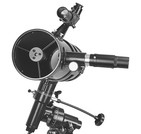Telescopes originated in glasses. Humans began using glasses about 700 years ago. Around 1300 AD, Italians began to make reading glasses from convex lenses. Around 1450 AD, myopic glasses also appeared. In 1608, an apprentice of the Dutch eyewear manufacturer H. Lippershey stumbled upon two lenses stacked together to clearly see things in the distance. In 1609, the Italian scientist Galileo Galilei heard about this invention and immediately made his own telescope and used it to observe the starry sky. Since then, the first astronomical telescope has been born. Galileo used his telescope to observe sunspots, craters of the moon, the moon moons (Galileo's moons), the profit and loss of Venus, and other phenomena, which strongly supported Copernicus' heliocentric theory. Galileo's telescope was made using the principle of refraction of light, so it was called a refractor.
In 1663, the Scottish astronomer Gregory used the principle of reflection of light to make a Gregorian mirror, but it failed to become popular due to immature production technology. In 1667, the English scientist Newton slightly refined Gregory's ideas and made a Newtonian mirror, which has an aperture of only 2.5 centimeters, but with a magnification of more than 30 times, and also eliminates the chromatic aberration of the refracting telescope, which makes it very practical. [1] In 1672, the Frenchman Cassegrin used concave and convex mirrors to design the Cassegrin mirror, which is now the most commonly used. This kind of telescope has a long focal length and a short mirror body, large magnification, and a clear image; It can be used both to study objects in a small field of view and to photograph large areas. Hubble uses this reflecting telescope.
In 1781, British astronomers W. Herschel and C. Herschel discovered Uranus with homemade 15-centimeter aperture mirrors. Since then, astronomers have added many functions to the telescope, making it capable of spectral analysis. In 1862, American astronomers and sons and Clark (A.Clark and A.G. Clark) created a 47-centimeter aperture refractoscope and took pictures of Sirius' companions. In 1908, American astronomer Hale led the construction of a 1.53-meter aperture mirror to photograph the spectrum of Sirius' companion. In 1948, the Haier Telescope was completed, and its aperture of 5.08 meters was enough to observe and analyze the distance and apparent velocity of distant objects. [2]
In 1931, German optomelist Schmidt made a Schmidt-type telescope, and in 1941, Soviet and Russian astronomer Maksutov made a Maksutov-Cassegrain refolding mirror, enriching the types of telescopes.
In modern and modern times, astronomical telescopes are no longer limited to optical wavelengths. In 1932, American radio engineers detected radio radiation from the center of the Milky Way, marking the birth of radio astronomy. After the satellite was launched in 1957, space astronomy telescopes flourished. Since the beginning of the new century, neutrinos, dark matter, gravitational waves and other new telescopes have been in the ascendant. Now, many of the information sent by celestial bodies has become the eyes of astronomers, and human horizons are becoming broader and broader. [2]
In early November 2021, after a long process of engineering development and integration testing, the much-anticipated James Webb Space Telescope (JWST) finally arrived at the launch site in French Guiana and will be launched in the near future.




